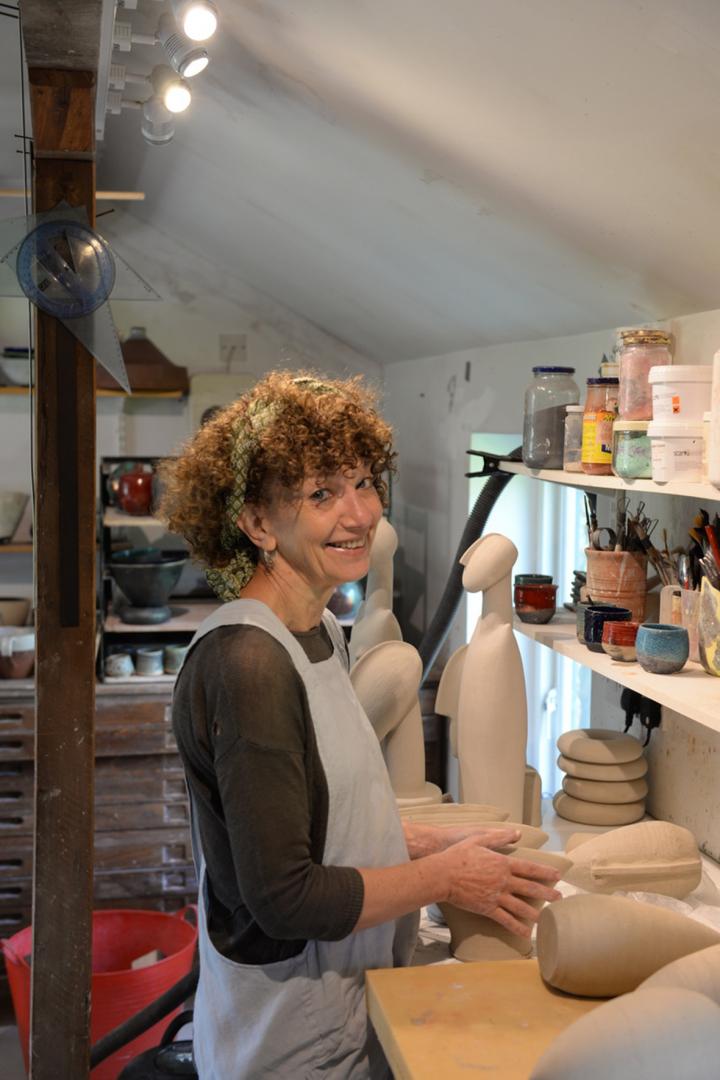Judy Caplin trained as a painter and printmaker before she discovered the wonders of clay, and never looked back. Her one-off pieces are thrown on a kick-wheel, which allows for more intimate contact between hand and machine. She works from her studio near, Mickleton, 200 yards from the River Tees.
Have you always been artistic – and has ceramics always been your first love?
Yes, I have always loved drawing and making things. I went to art school to study fine art – painting and printmaking – then I discovered ceramics.
What’s the attraction of working with clay – how did you get into it?
While I was doing an MA in painting and printmaking at the Slade School of Art, I went to an exhibition of the pottery made by Lucie Rie – it was a “Damascus” moment for me. Her pots embodied something that I was trying to achieve. From then on I knew I wanted to work in clay.
When you first started, did working with clay come naturally or was it something you had to work at?
I was always attracted to the material – I found it fascinating. It constantly changes. Just handling a lump of clay will dry it out, and on the wheel it’s solid but almost behaves like a liquid. Once it’s fired it’s virtually indestructible. There is so much to learn about all the materials – but it’s very intuitive, and you need to enjoy it.
At what point did you realise you could make a business out of ceramics?
Ha! That’s a bit of a trick question – I’m still getting there. Working with schools and community groups on participatory projects was a lovely way of combining ceramics and earning – getting artists into schools and “creative partnerships” was a brilliant initiative – benefitting both the schools and artists. There has been a bit of a revival in studio pottery recently and people are realising that something handmade is special. No two pieces are identical and they literally have the makers’ fingerprint.
What pieces do you most enjoy making – and why?
I like the diversity of the things I do. I love throwing bowls and everyday objects for functional use, but I wouldn’t like to do that all the time. I also love making sculptures, where the throwing is a means to an end and I manipulate the forms and join them together to create something new.
Then I also love raku firing where you can actually see how the heat transforms the pot and the glaze and makes something unique and unrepeatable.
My favourite form would have to be throwing the hollow sphere. It’s a technique I devised and involves really manipulating the clay on the wheel and then closing the form – a little bit of magic.
Making Hesperides, the hanging sculpture for The Witham, was a great opportunity. I’m always up for a new challenge.
What sort of art created by others do you enjoy – do you have a favourite artist and a favourite piece?
I’ve always loved Georgio Morandi’s paintings – very quiet unassuming still lives – bottles and vases in muted colours, but Lucie Rie’s bowls and vases are still up there. Some of the most powerful art is very very simple.
Over the years you have been involved in various arts groups/organisations in the dale. Is it important for artists, whatever their medium, to collaborate on things such as open studios, joint exhibitions, etc?
I think it’s vital. Making art can be a solitary and lonely activity and it’s really important to share ideas and support each other. It’s great working with other artists on projects.
Artworks in Teesdale was a charity that I co-founded with Jill Cole to get artists involved with community projects, schools and other organisations.
I’m now part of Teesdale ArtNet (TAN), a network open to anyone making artwork in the dale. We organise open studios, exhibitions and workshops.
In addition to ceramics, what keeps you busy?
Both my children live with their partners in London, so we try and visit there every few weeks although Covid has put a stop to that for the moment.
I’m secretary of Teesdale ArtNet and I volunteer for a charity DAR (Darlington Assistance for Refugees) which supports asylum seekers and refugee families in Darlington.
Otherwise I love cycling up and, even better, down the Teesdale hills, gardening, our doodle Mabel, chickens, cats and husband John, keep me pretty occupied.
How – if at all – has your work been affected by the lockdown?
I had an order cancelled as lockdown began, but that was reinstated once shops opened their doors in the now infamous picturesque market town of Barnard Castle.
Moth Gallery (part of Oswells Shop), on The Bank, stocks my functional domestic ware. I am really fortunate in having a studio at home so lockdown provided a great opportunity for uninterrupted making.
What’s next on your agenda?
TAN are gearing up for an exhibition pencilled in for November/December at The Witham and we’re planning open studios Events for April/May 2021
For anyone interested, where can they find out more about your work?
My website www.judy caplinceramics.co.uk has details of my work and links to my Instagram account where I post images of new work. I do have an online shop on my website, and also sell through Handmade in Britain and Jewel Street websites, while The Bowes Museum shop stocks some one-off pieces.






